Bass drum
| The drum kit |
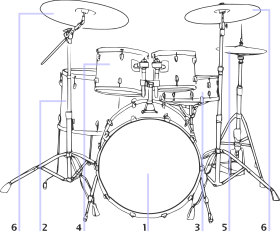 |
|
1 Bass drum | 2 Floor tom | 3 Snare 4 Toms | 5 Hi-hat | 6 Crash cymbal and Ride cymbal |
| Other components |
|
China cymbal | Splash cymbal | Sizzle cymbal |
A bass drum is a large drum that produces a note of low definite or indefinite pitch. There are three general classifications of bass drums: the concert bass drum, the 'kick' drum, and the pitched bass drum. The type usually seen or heard in orchestral or concert band music is the concert bass drum. The 'kick' drum, struck with a beater attached to a pedal, is usually seen on drum kits. The third type, the pitched bass drum, is generally used in marching bands and drum corps. This particular type of drum is tuned to a specific pitch and is usually played in a set of three to five drums. It is the largest drum of the orchestra.
Contents |
Usage
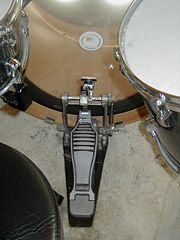
The bass drum is used in orchestral music, concert band music, marching music, and throughout 20th century popular music as a component of the drum kit for jazz and rock styles.
In popular music, the bass drum is used to mark time. In marches it is used to project tempo (marching bands historically march to the beat of the bass). A basic beat for rock and roll has the bass drum played on the first and third beats of a bar of common time, with the snare drum on the second and fourth beats, called "back beats". In jazz, the bass drum can vary from almost entirely being a timekeeping medium to being a melodic voice in conjunction with the other parts of the set. In classical music, the bass drum often punctuates a musical impact, although it has other valid uses. This instrument is used in many orchestras.
Orchestral bass drum
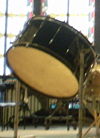
An orchestral, or concert bass drum is quite large, about 36" in diameter, and is played with one or sometimes two large, padded mallets. Usually the right hand plays the drum and the left hand muffles it. When played with both mallets, a knee or forearm can be used for damping.
Many different timbres, or sound-colors result depending on how and where the drum is struck. Implements used to strike the drum may include bass drum beaters of various sizes, shapes, and densities, as well as keyboard percussion mallets, timpani mallets, and drumsticks. Concert bass drums can sometimes be used for sound effects. e.g. thunder, or an earthquake.
Drum kit bass drum
A kit bass drum is played using a pedal-operated mallet or beater. A right-handed drummer will usually operate a pedal with the right foot.
In a drum kit, the bass drum is much smaller, most commonly 22" or 20" in diameter. Sizes from 16" to 26" diameter are quite normal, with depths of 14" to 22", 18" or 16" being normal. The standard bass drum size of past years was 20" x 14", with 22" x 18" being the current norm. Many manufacturers are now popularizing the 'power drum' concept similar to what tom-toms have gone through, with an 18" depth (22" x 18") to further lower the drum's fundmental note.
Sometimes the front head of a kit bass drum has a hole in it to allow air to escape when the drum is struck for shorter sustain. Muffling can be installed through the hole without taking off the front head. The hole also allows microphones to be placed into the bass drum for recording and amplification. In addition to microphones, sometimes trigger pads are used to amplify the sound and provide a uniform tone, especially when fast playing without decrease of volume is desired. Professional drummers often choose to have a customised bass drum front head, with the logo or name of their band on the front.
The kit bass drum may be more heavily muffled than the classical bass drum, and it is popular for drummers to use a pillow, blanket, or professional mufflers[2] inside the drum, resting against the batter head, to dampen the blow from the pedal, and produce a shorter "thud."
Different beaters have different effects, and felt, wood and plastic ones are all popular. Bass drums sometimes have a tom-tom mount on the top, to save having to use (and pay for) a separate stand or rack. Fastening the mount involves cutting a hole in the top of the bass drum to fix it, and 'virgin' bass drums do not have this hole cut in them, and so are professionally prized.
Bass drum pedal
William F. Ludwig made the bass drum pedal workable in 1909, paving the way for the modern drum kit.[3] A bass drum pedal operates much the same as a hi-hat, a "footplate" is pressed to pull a chain, belt, or metal "drive" mechanism downward, bringing a "beater" or mallet made of felt, wood, plastic, or rubber attached to a "shaft" forward into the drumhead. The pedal and beater system are mounted in a metal frame and like the hi-hat, a "tension unit" controls the amount of pressure needed to strike and the amount of recoil upon release. A double bass drum pedal operates much the same way only with a second footplate attached by rod to a remote beater mechanism.[4][5]
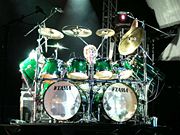
Double bass drum
In some forms of jazz, many forms of heavy metal, fusion and some forms of punk, two bass drum pedals are used, one operated by each foot or a double-bass pedal used to utilize two pedals with only one bass drum. The idea for the double bass drum setup came from jazz drummer Louie Bellson when he was still in high school. Double bass drums were used initially by jazz artists such as Ray McKinley and Ed Shaughnessy in the 1940s and 1950s, and popularized in the 1960s by rock drummers Ginger Baker of Cream, Keith Moon of the Who[6] and Nick Mason of Pink Floyd[7]. Originally two tuned bass drums were used for this, but a double pedal on one bass drum using an extension mechanism is now common due to lower cost and ease of tuning. But with a double bass pedal, because of the amount of air being moved around, amplification problems can occur especially live, and many inconsistencies with studio recording.
With most extreme metal players using trigger pads from a drum module to make the bass drum recording/playing live easier, there is controversy about 'tapping' and 'cheating' by using high sensitivities in order to play fast, consistent sixteenth or thirty-second notes. There are, however, extreme metal drummers that do not use triggers all the time - for example, Derek Roddy, ex-drummer for Hate Eternal, demonstrated several times at his clinics the ultra-high speed double bass just with normal microphones. Other very fast double-bass players include Pete Sandoval of Morbid Angel, who is usually considered the pioneer of truly fast death metal blast beats, Gene Hoglan, formerly of Strapping Young Lad, known by the nickname "The Atomic Clock," Dave Mackintosh of Dragonforce, and Nicholas Barker, ex-drummer of Dimmu Borgir. Some drummers have also experimented with two different bass drum tunings, sometimes combining this with double beaters so as to have more than two pedals. This is also used to create a definite tone difference between the drums. Tim Alexander from the band Primus is known for doing so. Amongst others, Vinnie Paul, Virgil Donati, Mike Portnoy, Thomas Lang and Tomas Haake are known to incorporate an original type of double bass drumming into their style.
Drop-clutch
When using a double bass drum pedal, the foot that normally controls the hi-hat pedal moves to the second, 'slave', bass drum pedal, and so the hi hat opens. When it is open, the notes will ring rather than click, as they do when it is closed, and so some drummers choose to use a drop-clutch.
A drop-clutch is a mechanism used to disengage and drop the top hi-hat in order to free up both feet while playing double bass drums. This results in the hi-hat producing a closed sound until the hi-hat foot is available again. Drop-clutches may be activated in various ways depending on manufacturer, by hitting the clutch either on the side or top down with a drumstick or by pressing a locking footpedal as with a Tama "Cobra Clutch" product which also allows for control over how much the hi-hat cymbals are closed. The clutch can be disengaged by pressing the hi-hat completely down or with the Cobra clutch, by pressing the unlocking pedal.[4][8]
Techniques
The most common method of bass drum playing is a "heel-up" technique: the pedals are struck with the ball of the feet using force primarily from the thigh as opposed to the ankles when using the "heel-down" technique. Most drummers play single strokes, although there are many who are also capable of playing doubles or paradiddles. Musicians such as Thomas Lang or Virgil Donati are capable of performing impressively complicated solos on top of an ostinato bass drum pattern. Thomas Lang, for example, has mastered the heel-up and heel-down (single- and double-stroke) to the extent that he is able to play dynamically with the bass drum and to perform various rudiments with his feet.
In order to play "doubles", exponents of the "heel up" technique use either one of two techniques: the "slide technique" or the heel-toe technique. In the slide technique, the pedal is struck around the middle area with the ball of the foot. As the drum produces a sound, the toe is slid up the pedal. After the first stroke, the pedal will naturally bounce back, hit the toe as it slides upwards, and rebound for a second strike. In the heel-toe technique the foot is suspended above the foot-board of the pedal and the first note is played with the heel. The foot snaps up, the heel comes off the footboard, and the toes come down for a second stroke. Once mastered it allows the player to lay down very rapid rolls on the bass drum. Noted players include Nicholas Barker, Rod Morgenstein, Jan Axel Blomberg, George Kollias, Pete Sandoval,Tim Waterson, Chris Adler, Travis Smith, and Danny Carey. The technique is commonly used in death metal and other extreme forms of music.
In certain types of heavy metal and punk, drummers play a constant stream of rapid-fire notes on the bass drum, and the ability to play evenly at extremely high tempos is a skill prized within the heavy metal scene. Some examples of profficient drummers with this ability are Avenged Sevenfold's The Rev, Joey Jordison of Slipknot, as well as many metalcore/death metal drummers such as Jordan Mancino from As I Lay Dying, Lamb Of God's Chris Adler and Jason Bittner of Shadows Fall; thrash drummers Dave Lombardo of Slayer/Testament, and Louie Clemente, formerly of Testament; and in Scandinavian Metal: Children Of Bodom's Jaska Raatikainen and Samu Ruotsalainen of Fintroll and several other similar bands. Many extreme metal, thrashcore and grindcore drummers use a combination of fast double bass drum patterns, the snare, and the cymbals to create blast beats.
With two feet playing bass drum, many of the techniques of snare drum playing (such as rudiments and rolls) can be performed on the bass drums.
Marching bass drum
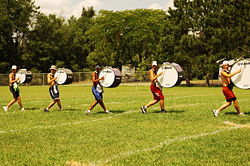
The "bass line" is a unique musical ensemble consisting of graduated pitch marching bass drums commonly found in marching bands and drum and bugle corps. Each drum plays a different note, and this gives the bass line a unique task in a musical ensemble. Skilled lines execute complex linear passages split among the drums to add an additional melodic element to the percussion section. This is characteristic of the marching bass drum — its purpose is to convey complex rhythmic and melodic content, not just to keep the beat. The line provides impact, melody, and tempo due to the nature of the sound of the instruments.
Components
A bass line typically consists of between four and five musicians, each carrying one tuned bass drum, although variations do occur. Smaller lines are not uncommon in smaller groups, such as some high school marching bands, and several groups have had one musician playing more than one bass drum, usually small ones, with one mounted on top of the other.
The drums are typically between 16" and 32" in diameter, but some groups have used bass drums as small as 13" and larger than 36". The drums in a bass line are tuned such that the largest will always play the lowest note with the pitch increasing as the size of the drum decreases. Individually, the drums are tuned higher than other bass drums (drumset kick drums or orchestral bass drums) of the same size, so that complex rhythmic passages can be heard clearly and articulated.
Unlike the other drums in a drumline, the bass drums are generally mounted sideways, with the drumskin facing horizontally, rather than vertically. This results in several things. First of all, to ensure that a vibrating membrane is facing the audience, bass drummers must face perpendicular to the rest of the band and so are the only section in most groups whose bodies do not face the audience. Consequently, bass drummers usually point their drums at the back of the bass drummer in front of them, so that the drum heads will all be lined up, from the audience's point of view, next to one another in order to produce optimal sound output.
Playing a marching bass drum
Since the bass drum is oriented differently than a snare or tenor drum, the stroke itself is different, but the fundamentals remain the same. The drum is mounted on the chest, with the heads pointing to the left and to the right. The arm is bent at the elbow and the forearms are held parallel to the ground and nearly parallel to the drum head. The hands hold bass mallets in such a way as to place the center of the mallet in the center of the head.
The motion of the basic stroke is either similar to the motion of turning a doorknob, that is, an absolute forearm rotation, or similar to that of a snare drummer, where the wrist is the primary actor, or more commonly, a hybrid of these two strokes. Bass drum technique sees huge variation between different groups both in the ratio of forearm rotation to wrist turn and the differing views on how the hand works while playing. Some techniques also call for the use of fingers supporting the motion of the mallet by opening or closing.
However, the basic stroke on a drum produces just one of the many sounds a bass line can produce. Along with the solo drum, the "unison" is one of the most common sounds used. It is produced when all of the drums play a note at the same time and with a balanced sound; this option has a very full, powerful sound. The rim click, which is when the shaft (near the mallet head) is struck against the rim of the drum, either solo or in unison. Rimshots are rare on a bass drum and usually only happen on the top drums.
The different positions of the typical five person bass line each require different skills, though not necessarily different levels of skills. Contrary to the popular belief that "higher is better," each drum has its own critical role to play.
Bottom, or fifth bass, is the largest, heaviest, and lowest drum in the drumline. Consequently, it is used frequently to help maintain pulse in an ensemble and is thus sometimes referred to as the "heartbeat" of the group (the bottom bass was also often referred to as the "thud" bass in days gone by, indicating that many of their notes were the last one at the end of a phrase). Although this player does not always play as many notes as fast as other bass drummers (the depth of pitch renders most complex passages indistinguishable from a roll), his or her role is absolutely essential not only to the sound of the bass line or the drum line, but to the ensemble as a whole, especially in the case of parade bands.
Fourth bass is slightly smaller than the bottom drum (generally two to four inches smaller in diameter) and can function tonally similarly to its lower counterpart, but usually plays slightly more rapid parts and is much more likely to play "off the beat" - in the middle rather than at the beginning or end of a passage.
Third bass is the middle drum, both in terms of position and tone. Its function is usually that of the archetypical bass drum. This player plays an integral role in the actual rendering of complex linear passages.
Second bass has arguably the most difficult job in the drumline. This player's parts are very likely to be directly adjacent to the beginning or end of a phrase and less likely to be on a beat, which is highly counter-intuitive, especially to a new player. Sometimes this drum can function about the same as the top drum, but usually the second and top drummer function as a unit, playing very rudimentally difficult passages split between them.
Top, or first, bass is the highest pitched drum in the bass line and usually starts or ends phrases. The high tension drum heads allow this player to play notes that are just as taxing as those of the snare line, and often the top bass will play a part in unison with the snare line to add some depth to their sound.
Muffling a marching bass drum
There are a few different ways to properly muffle a marching bass drum. Unlike the bass drum on a drumset, muffling should not lie inside the drum and should only be a thin strip of foam glued either to the outside part of the head, glued to the inside of the shell protruding about or with certain heads "wedged" in between the inside part of the head and a clear ring that goes all the way around the head.
Audio samples
External links
- Historic Field Drums (including Bass Drums)
- How To Record The Perfect Kick Drum Sound- Tips on recording your bass drum
References
- ↑ "The Dance Music Manual: Tools, Toys and Techniques", Rick Snoman (2004) ISBN 0240519159
- ↑ See, for example, the Protection Racket bass drum muffler
- ↑ The Drum Book: The History of the Rock Drum Kit (Geoff Nichols, 1997), p. 8-12
- ↑ 4.0 4.1 "Pearl Drums Hardware" 2004
- ↑ Marshall, Paul. Radcliff, Mike. "Glossary of Terms (Drum kit/Drumset)" 1999
- ↑ History of double bass @ Drummers Digest
- ↑ Why did Nick have two bass drums? - Printable Version
- ↑ Tama. "Cobra Clutch"
|
|||||||||||